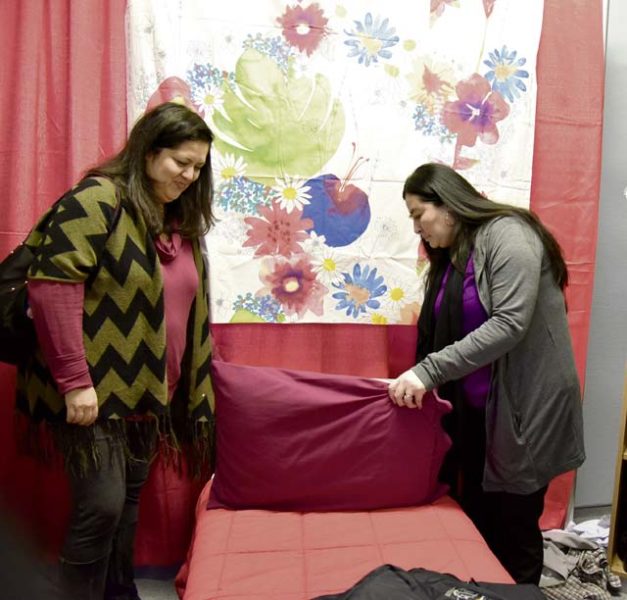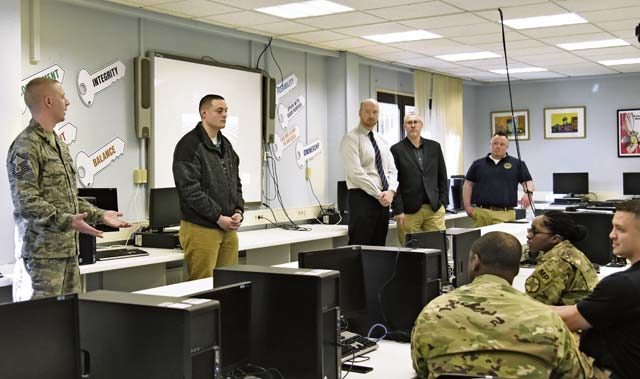
What can adults learn from a cluttered teen bedroom? That’s what “Hidden iN Plain Sight” participants found out Feb. 13 at Kaiserslautern Middle School. Hidden iN Plain Sight is designed to help the U.S. Army Garrison Rheinland-Pfalz adult community spot the warning signs of at-risk behavior by providing a hands-on training exhibit of a typical teenager’s bedroom for parents, educators, unit leadership, law enforcement and concerned adult community members to recognize common items that may be indicative of substance abuse.

The training — the first of its kind in Installation Management Command-Europe — is a collaborative effort of community professionals, to include the garrison Army Substance Abuse Program and Civilian Misconduct offices, Ramstein and Kaiserslautern Adolescent Support and Counseling Services and U.S. Army Criminal Investigation Command Kaiserslautern Drug Suppression Team investigators.
“The goal of HiPS is to ensure our community adults have the tools necessary to assist our youth with making smart choices, avoiding substance abuse and recognizing how to obtain appropriate assistance, should they need it,” said Robert Leist, USAG RP Assistant Civilian Misconduct officer.
During the two-hour training program, participants receive an introduction of community services, use and abuse trends happening in the community, an overview of ASACS and information on how host nation criminal laws apply to overseas civilians under the Status of Forces Agreement. Next, participants are given 15 minutes to identify items of concern and training aids of illicit substances in a mock teenager’s bedroom exhibit. Later, CID investigators demonstrate a crime scene search and reveal items of concern or training aids that were not previously found. Afterward, the Civilian Misconduct office presents information on actions that can occur should an incident of misconduct be identified. Lastly, a question-and-answer panel with community professionals rounds out the training.
“If this training can help a family working through alcohol or drug abuse or educate them on strategies to prevent adolescent substance abuse behaviors — it served its purpose,” said Susanna Leist, ASAP Prevention coordinator and Employee Assistance Program coordinator. “Society places incredible stress on our young people, and it is our job to provide tips and resources to help them make that difficult transition into adulthood by keeping them safe and supported now.”
Another avenue to keep youth safe and supported is through the Adolescent Support and Counseling Services program. ASACS is a school- and community-based program providing free, confidential, voluntary and supportive counseling and educational prevention-based services for students from sixth to 12th grade in the Kaiserslautern Military Community. ASACS counselors are dually credentialed through their respective clinics and serve at Kaiserslautern and Ramstein middle and high schools.
Across the KMC, Germany and the European theater as a whole, alcohol, multiple forms of marijuana and products containing dextromethorphan, commonly referred to as “Triple Cs,” remain the most consistently used and abused drugs, said Dillon Welliver, ASACS clinical supervisor.
“We are also seeing an increase of Attention Deficit Disorder prescription usage,” Welliver explained. “Typically, youth either abuse their prescriptions or obtain them from their friends.”

Probably the No. 1 mitigating factor when it comes to preventing adolescent alcohol and drug use is parental engagement, Welliver said.
“Knowing your kids, knowing who their friends are and just being a part of their daily lives is the biggest anti-drug action a parent can take,” he said. “If people suspect teens may be drinking or using drugs, address it with them directly. Displaying a genuine, calm, direct and kind approach will yield positive results. You can also contact your local ASACS counselor for assistance.”
As a parent of four boys, Rosie Hillburn said the course was very informative.
“I liked this training because it provided a lot of information about the resources in the community,” said Hillburn, a Family Readiness Support assistant for the 10th Army Air and Missile Defense Command and 5th Battalion, 7th Air Defense Artillery Regiment. “The hands-on portion was very useful and showed us what the trends are and what to look for.”
The HiPS initiative was proposed by USAG RP Commander Col. Keith E. Igyarto to bring awareness to current adolescent high-risk incidents of misconduct and provide the community with the tools needed to enhance the safety and security of the garrison.

“This program empowers our community to better identify signs of use or abuse to protect the safety and welfare of our youth and our military communities,” the commander said. “The more who attend and acquire the tools to help our youth achieve success, the safer and more successful our community will be.”
For more information or to sign up for future HiPS training, call USAG RP ASAP at 493-4909 or 0631-3406-4909; 493-1710 or 0631-3406-1710.


